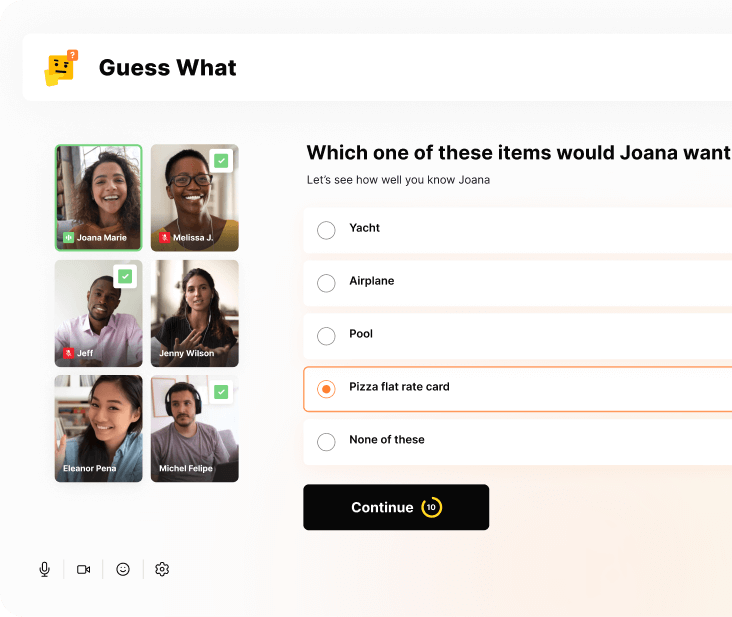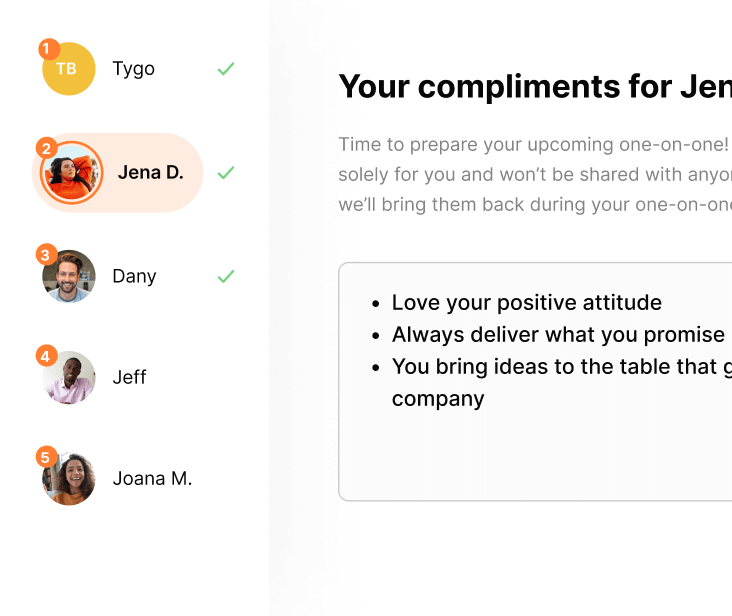Back to Blog
10 proven questions and templates for employee engagement surveys
Understanding what your employees need can be tricky. Employee engagement surveys take the guessing away and help you make informed decisions. But the way you ask your questions matters.
The environment at work, the level of connection your employee feels to the mission, and the results of past surveys all impact your results. Plus, you’ll need to track metrics over time to make an actionable plan moving forward.
Here’s your one-stop shop for employee engagement surveys.
Here are the best sample questions for employee engagement surveys
One of the first things to decide is whether you want to offer employee engagement survey questions that are open-ended or close-ended. Open-ended questions leave room for the respondent to come up with an answer, starting with things like “What do you feel…” or “Tell me about a time…”. Close-ended questions offer a set of answer choices, like yes or no, a scale of 1-10, or options ranging from “very happy” to “very dissatisfied.”
With open-ended questions, data analysis may require more time. With close-ended questions, you have to be very careful to offer a range of options so the results are less biased by the options provided. Offering an “other” option can help to get the best of both worlds.
Your company will have their own spin on a survey on employee engagement, but here are the kinds of key questions you should ask:
Share fun facts and bond with a team quiz
Have your participants choose from a list of questions they’d like their coworkers to answer about them, before watching as they guess the right answer.
01. Yes
share-fun-facts-and-bond-with-a-team-quiz

Run a guided recognition activity
Have your participants choose from a list of questions they’d like their coworkers to answer about them, before watching as they guess the right answer.
01. Yes
run-a-guided-recognition-activity

Organize a virtual cooking class
Hire a professional chef to help your team cook a delicious lunch or dinner. May be difficult for co-workers with families. To find providers and get tips, read our blog about virtual cooking classes.
02. No
organize-a-virtual-cooking-class

Hire a stand-up comedian
Have your participants choose from a list of questions they’d like their coworkers to answer about them, before watching as they guess the right answer.
02. No
hire-a-stand-up-comedian

No items found
No items found
Table of contents
Understanding what your employees need can be tricky. Employee engagement surveys take the guessing away and help you make informed decisions. But the way you ask your questions matters.
The environment at work, the level of connection your employee feels to the mission, and the results of past surveys all impact your results. Plus, you’ll need to track metrics over time to make an actionable plan moving forward.
Here’s your one-stop shop for employee engagement surveys.
Here are the best sample questions for employee engagement surveys
One of the first things to decide is whether you want to offer employee engagement survey questions that are open-ended or close-ended. Open-ended questions leave room for the respondent to come up with an answer, starting with things like “What do you feel…” or “Tell me about a time…”. Close-ended questions offer a set of answer choices, like yes or no, a scale of 1-10, or options ranging from “very happy” to “very dissatisfied.”
With open-ended questions, data analysis may require more time. With close-ended questions, you have to be very careful to offer a range of options so the results are less biased by the options provided. Offering an “other” option can help to get the best of both worlds.
Your company will have their own spin on a survey on employee engagement, but here are the kinds of key questions you should ask:
10 real examples and resources for employee engagement surveys
We found some effective examples of employee engagement surveys to show you how you might personalize the general categories of key questions.Take these resources as inspiration, or get started with the templates right away.
Templates:
- This Typeform employee engagement survey template.
- Leapsome offers a template and 72 great survey questions.
- Zavvy’s free employee engagement survey template.
- SurveyMonkey’s template offers a variety of questions in an easy-to-follow form.
- Qualtrics offers both beginner and advanced employee engagement survey templates.
Other resources:
- Companies like Relay Payments and Apple implement a live employee engagement survey that is called a stay interview. This is a one-on-one meeting where you ask questions about engagement that focus on why this individual wants to stay at the company. It could also uncover disengagement or disconnection. While their templates aren’t available, there is a Stay Interview app for iPhone!
- Achievers shares the top 20 questions to include on your survey.
- Basecamp offers a course on their “employee experience programs,” which builds on a standard survey and makes the process more integrated into your workflows.
- Sheila Margolis, an organizational culture expert, offers this structure for creating survey questions.
- The Net Promoter System has a book out. It’s called Winning on Purpose, talking about how companies harness the power of customer satisfaction. Their employee-engagement-focused version is the employee Net Promoter System or eNPS.
Avoid these mistakes with employee engagement surveys
There are four major mistakes in employee engagement surveys. The best practices to improve your employee engagement surveys involve avoiding these errors to keep your results useful. Making mistakes can make your data inaccurate or cause people to stop filling them out.
- Doing long surveys too often. There is a real condition called survey fatigue. It’s where survey results get less accurate after people have been polled too often. Keep frequent surveys to only 1 or 2 questions. This way, your big, occasional surveys have accurate results.
- Punishing critical feedback. Don’t publicly call out anyone who offers suggestions for change. If you make them feel punished for their honesty, the whole team will notice. They may start thinking they need to say they are happy and feel fulfilled at work on every survey. This ruins your data.
- Asking questions with biased responses. It may be tempting to only give “super satisfied,” “very satisfied,” and “satisfied” as options for how people feel at work. But biased questions yield bad results. There have to be enough options for people to express their concerns. Otherwise, you may be hiding big issues.
- Never publicly making changes because of the surveys. If you’ve crunched the numbers and found the patterns, you need to showcase what you will do about it. Your employees will take future surveys more seriously if they see you pulling actionable next steps from the survey data and showing it to the company.
Tools that help you create and analyze engagement surveys
Analyzing your data can go faster and generate more useful visualization if you use an employee engagement survey app or platform. These tools help you keep best practices in mind and distribute surveys easily through existing infrastructure like Slack.
- OfficeVibe – provides automated pulse surveys featuring different question types and helps you keep an overview of different engagement metrics.
- Culture Amp - After you get data from surveys, use Culture Amp to see trends and visualize concerns in the data so you can make changes.
- TINYPulse - with easy app-based surveys, get higher rates of return and make frequent check-ins with your employees the norm.
- Qualtrics - A robust survey software that can be just as useful for polling customers and potential leads as it is for engaging your employees and evaluating the data.
- Energage - Offers extensively researched template questions for a great employee survey experience.
- 15Five - Focused on the idea that frequent, short surveys help you know your team better, this tool also offers various coaching options for engaging with the issues you may uncover in continuous employee engagement surveys.
It’s not the end of the world if you need an employee engagement overhaul - just get started
If you make a great employee engagement survey, you may realize your employees are disconnected. Feeling disconnected can lead to employee turnover or employee disengagement. This may mean less of the great work you want. The right time to address employee engagement is now. Consider implementing new techniques to engage your employees today:
- Try these virtual employee engagement platforms.
- Browse the best employee engagement apps.
- Dig into relevant employee engagement statistics.
- Learn more about how to make remote employees feel connected.
- Incorporate team building activities: In-office, virtual and/or free
- Need more? We’ve got even more employee engagement solutions.
Frequently asked questions
Here’s everything you need to know about employee engagement surveys, from basics to their purposes and impacts.
What is an employee engagement survey?
An employee engagement survey is a set of questions distributed to employees. This survey evaluates whether they feel connected and fulfilled at work. Positive results show that company culture is strong and there aren’t issues that management has missed.
What is the purpose of employee engagement surveys?
Employee engagement survey questions identify areas that can cause an employee to not produce their best work or even leave the company. These include assessing employee loyalty, satisfaction, effort, and trust. Ultimately, the goal is to keep turnover low.
What’s the difference between an employee engagement survey and an employee satisfaction survey?
In general, an employee satisfaction survey measures one straightforward element. It’s whether employees are happy with their workplace at this moment in time. Engagement encompasses much more. It includes a willingness to grow with the company, an effort to do one’s best work, and a connection to the work. These factors may or may not exist just because an employee is “satisfied.”
How often should I measure employee engagement?
Multiple shorter surveys are generally considered more effective than one long annual survey. Consider doing medium-length surveys quarterly. Then, 1-question pulse surveys can be done monthly or bi-weekly. This way, you can track if employee engagement goes down or up as things change in the company.
Do team engagement survey questions even work?
Ask survey questions in a way that gives you data over time. With multiple data points, these surveys can give you key trends about your team. However, they are only as effective as how you use the results. Teams will keep filling out surveys if you take them seriously. Team members need to see the changes implemented publicly.
What should I ask on a new employee engagement survey?
Employee engagement survey questions can be effective right after hiring. Start with a question about the onboarding process. Then consider a question about the effectiveness of the workplace compared to past employers.
Subscribe to get our latest updates
Subscribe to get our latest updates
.webp)





